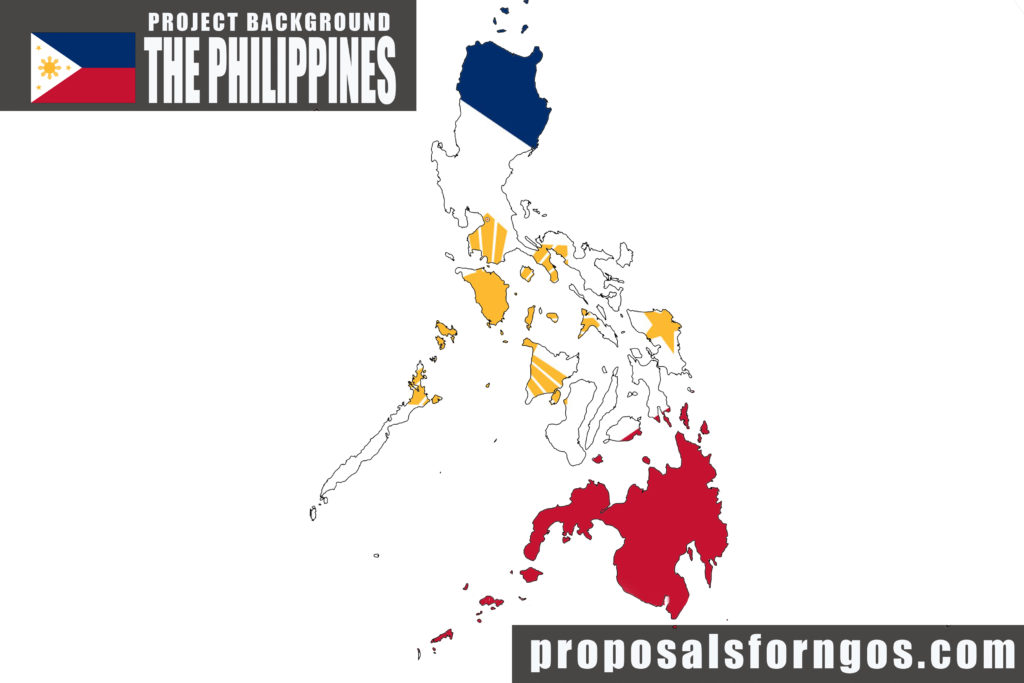The project background is an important part of every proposal. It can be very similar to the project rationale or the project justification. It shows your donor that you did your homework and that your project is planned well. But where can you get the information and data for your project background? And how does one actually look like?
Here you have an example project background for the Philippines.
If you are planning or working in the Philippines then you are welcome to use this blueprint. Be sure to add more specific information about your own project though, and add other relevant data according to the region and sector you are working for.
Project Background of the Philippines
The Philippines is a South-East Asian country, a former Spanish colony, located in the Western Pacific Ocean. The country is made up of more than 7,600 islands, of which Manila is the capital. Its geographical position means its closest neighbors are Indonesia, Vietnam, China, and Taiwan. The country of the Philippines is located on the Ring of Fire, an area where respectively roughly 90% and 75% of the world’s earthquakes and volcanic activity occurs.
The population in the Philippines is 104,256,076, among which 83,4% live in rural and 16,6% in urban areas. The agriculture sector is therefore, the most important source of economic activity in the country, followed by industry and services. The literacy rate is 62.1% of the population with an average of 11 years of schooling.
Despite having been unhindered during the 2008 global banking crisis, the Philippines has enjoyed constant growth during that period, and a noteworthy $874.5 billion in GDP.
More than half of the Filipino population (50.7%) still lives under the poverty line. This translates into relatively low life expectancy averaging at 64 years, relatively high child and maternal mortality rates (respectively at 19.9% and 114 death for every 100,000 live births), as well as 19.9% malnourishment in children. The country stands at 111 out of the 180 countries measured by Transparency International in the Corruption Ranking.
Country: Philipines
Source: CIA The World Fact book (unless otherwise indicated)
Demographics
- Population: 104,256,076
- Density: 197.518 per sq/km (The World Bank)
- Area (Rural/ Urban) – 83.4% / 16.6%
- Under poverty line: 50.7%
Education
- Literacy rate- 62.1%
- Average schooling Years – 11
- Male vs. Female schooling years. –12/13
Health
- Average life expectancy- 64 years old
- Child mortality – 19.9%
- Maternal mortality- 114 deaths/100,000 live births
- Stunting/Malnourishment in children- 19.9%
- Fertility rate – 3.02 children born/woman
Economy
- Most important sectors- Agriculture, Industry and Services
- GDP – $874.5 billion
- Unemployment rate- 6%
Ecology
- % of forested area- 25.9%
- Number of National Parks – 35 National parks
Other:
- Rank Gender Equality Index -0.649 (http://hdr.undp.org/en/composite/GII)
- Child marriage- 48% (20-24) 1986) 2003 (UN data)
- Human Development Index- 0.699 (http://hdr.undp.org/en/countries/profiles/PHL)
- Corruption Rank- 111/180 (https://www.transparency.org/country/PHL)
- Ease of doing business- 58.74 (http://www.doingbusiness.org/data/exploreeconomies/philippines)

